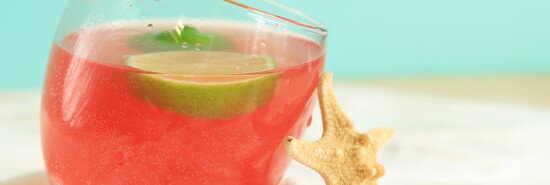
Drink like a preppy in summer with this historical cocktail recipe for the ‘pink and green’
Eric Felten
Video Embed
About a century and a half ago, there was a bartender named A. William Schmidt who styled himself as “The Only William.” There is no doubt that he was, as his handle suggests, unique. In particular, The Only William created cocktails of such inscrutable complexity as to be expressions of radical individualism. If only they were as good as they were elaborate.
There is a general rule in the making of mixed drinks: Combine more than three ingredients, and you’ll likely end up with a mess. That risk didn’t daunt William, who wrote an 1892 book, The Flowing Bowl: When and What to Drink, full of drink recipes crowded with extraneous ingredients. Consider a drink that only The Only would slide across the mahogany, an extravagance he named the New York Herald. The drink is made for two, and William declares it to be “intended for an evening drink, only on special occasions.” The recipe calls for two egg yolks (save the egg whites for later), the juice of an orange, a splash of pineapple juice, a spoonful of sugar, a couple of ounces of fine brandy, an ounce of kirschwasser (that is, unaged cherry brandy), half an ounce curacao, half an ounce maraschino liqueur, half an ounce creme de roses, two dashes of Benedictine, and two dashes creme de cocoa.
I’M A BOOK MAN, NOT A BEACH READER
I made the New York Herald cocktail as the recipe specified, including whipping up the egg whites for a merengue-y topping. It was vile.
I tried it again, this time without the egg yolks. It still scored deep in the red on the vile-ometer. I went back to the shaker and mixed it all up again minus the egg yolks and without the Benedictine and chocolate liqueur. Nasty. How about without the orange juice? Nasty nasty.
What if we get rid of the pineapple juice, the cherry brandy, and the maraschino liqueur? Not nearly as emetic, perhaps because cognac (the “fine” brandy William calls for) is nearly the only ingredient left. Alas, cognac is better than cognac with creme de roses.
Which raises the question: What is this creme de roses business anyway? The Only William clearly liked the sweet, pink stuff, a liqueur made by macerating rose petals in alcohol and adding sugar. William used it in his various kitchen-sink cocktails, such as the drink made by combining creme de roses with anisette, maraschino, vanilla liqueur, a fruity cordial called Parfait D’Amour, chocolate liqueur, brandy, Benedictine, and another monastic product, Celestine. I’m beginning to suspect our friend Willie was the bartender at Bellevue.
In these 17-car pile-ups, there’s no making out the flavor of the rosy cordial. So, what is it good for? Notwithstanding The Only William’s habit of tossing it into just about anything, and notwithstanding professor Schmidt’s taste in matters involving liqueurs having already been proved suspect, there was one sort of cocktail where it did excel, and that was in pousse cafes. These are unmixed drinks made by pouring — carefully over the back of a spoon — half a dozen liqueurs of various colors into a small glass. The rainbow of layers makes for a visually stunning drink, though one too sweet to actually be consumed with pleasure.
So, what is this liqueur good for? The French cordial company Combier suggests using it for a spritz by mixing it with either Champagne or prosecco. A dry Champagne is far and away the better of these two choices because adding a sweet liqueur to fizzy wines as sweet as most Italian bubblies will make your teeth hurt.
But I do think I’ve stumbled on a perfect purpose for creme de roses. One of the great drinks of summer, and a particular favorite of preppies, is the gin and tonic. It isn’t much to look at, as gin and tonic water are both usually colorless ingredients. A properly made G&T uses the juice of half a lime, the shell of which is dropped into the glass. Add a little rose liqueur, and the tonic turns to the exact hue of a Brooks Brothers pink oxford button-down. I call it a “Pink and Green,” the definitive preppy color combination. Just please don’t muck it up with Benedictine and Celestine.
CLICK HERE TO READ MORE FROM THE WASHINGTON EXAMINER
Eric Felten is the James Beard Award-winning author of How’s Your Drink?
